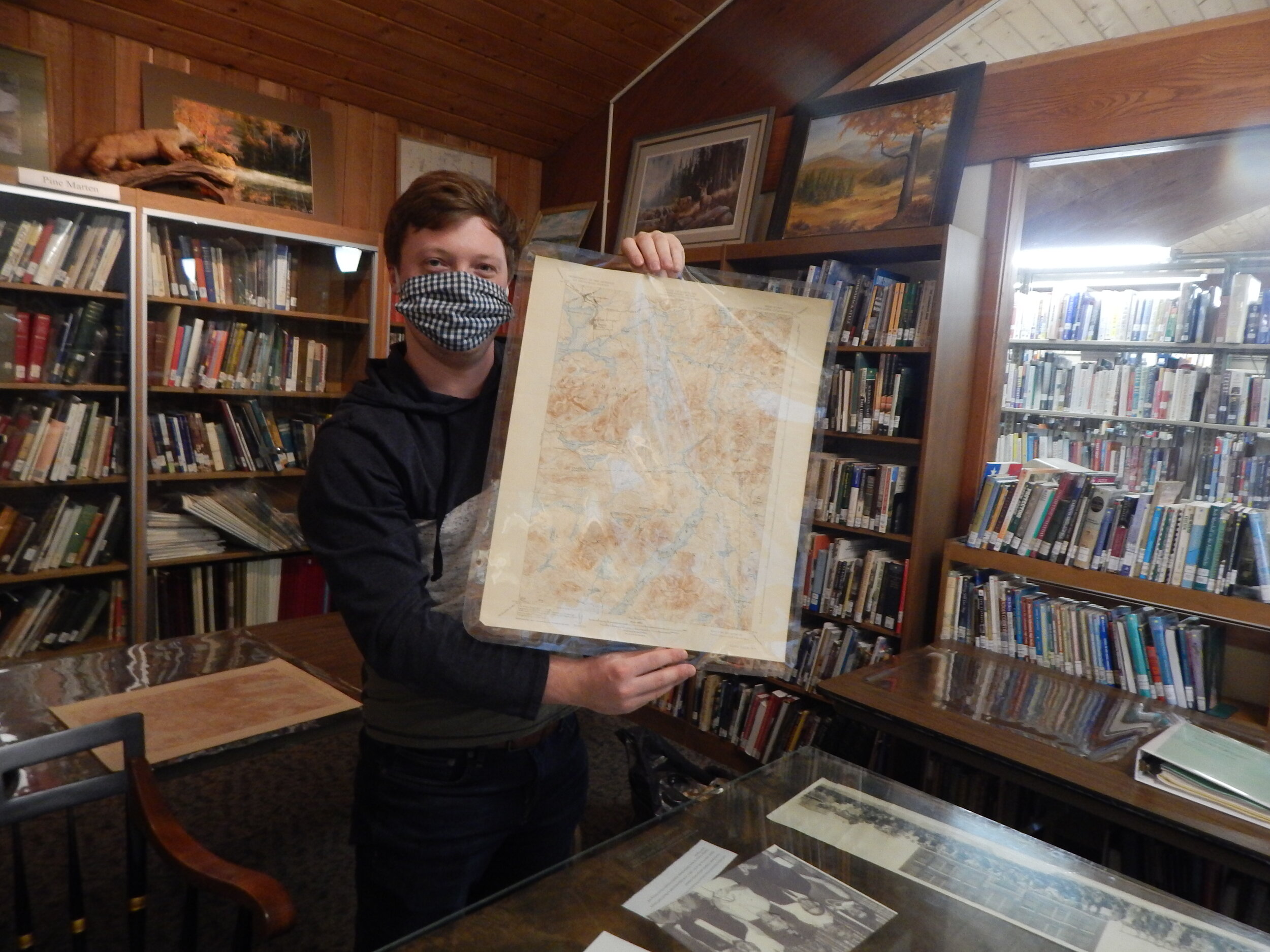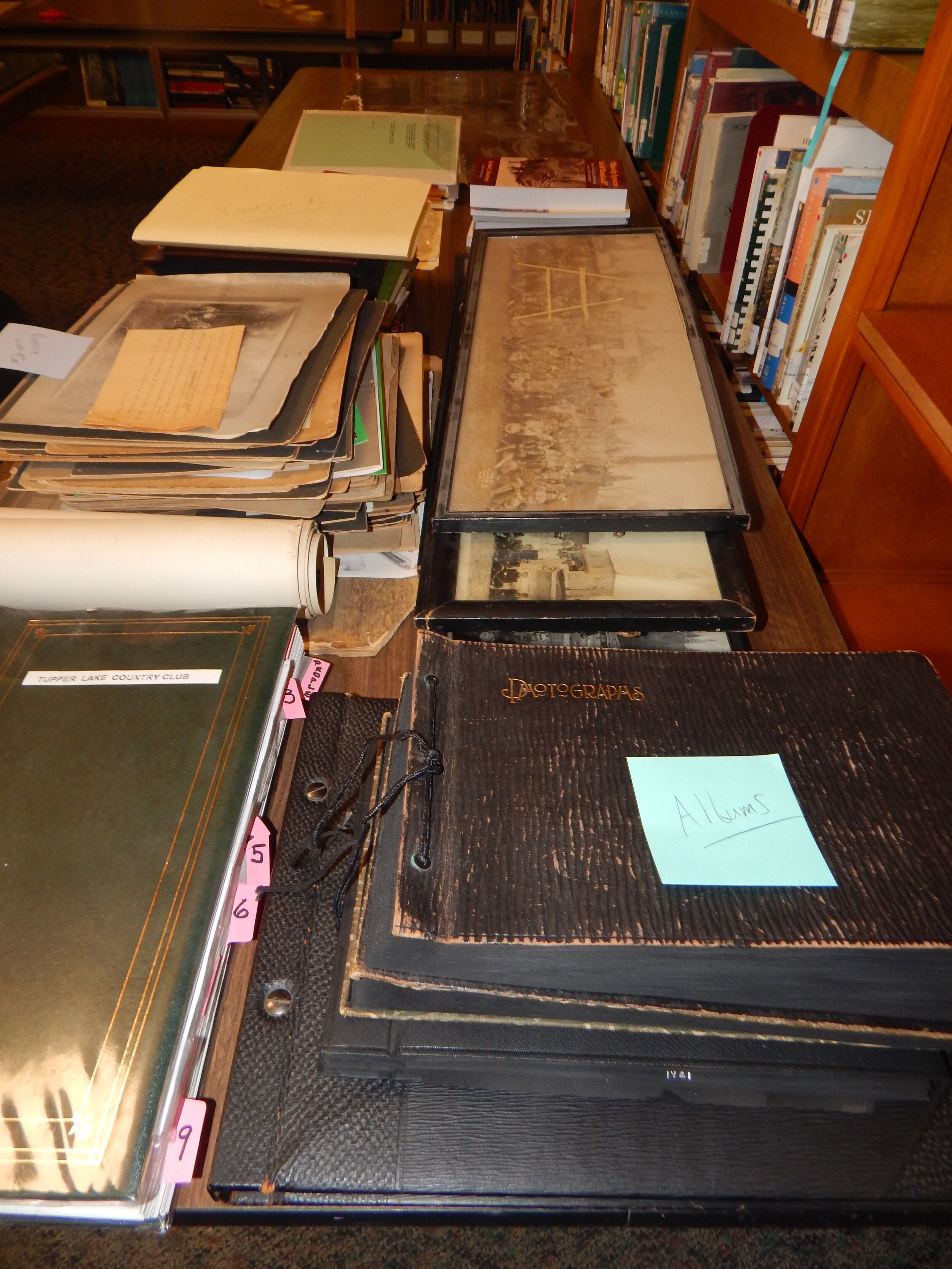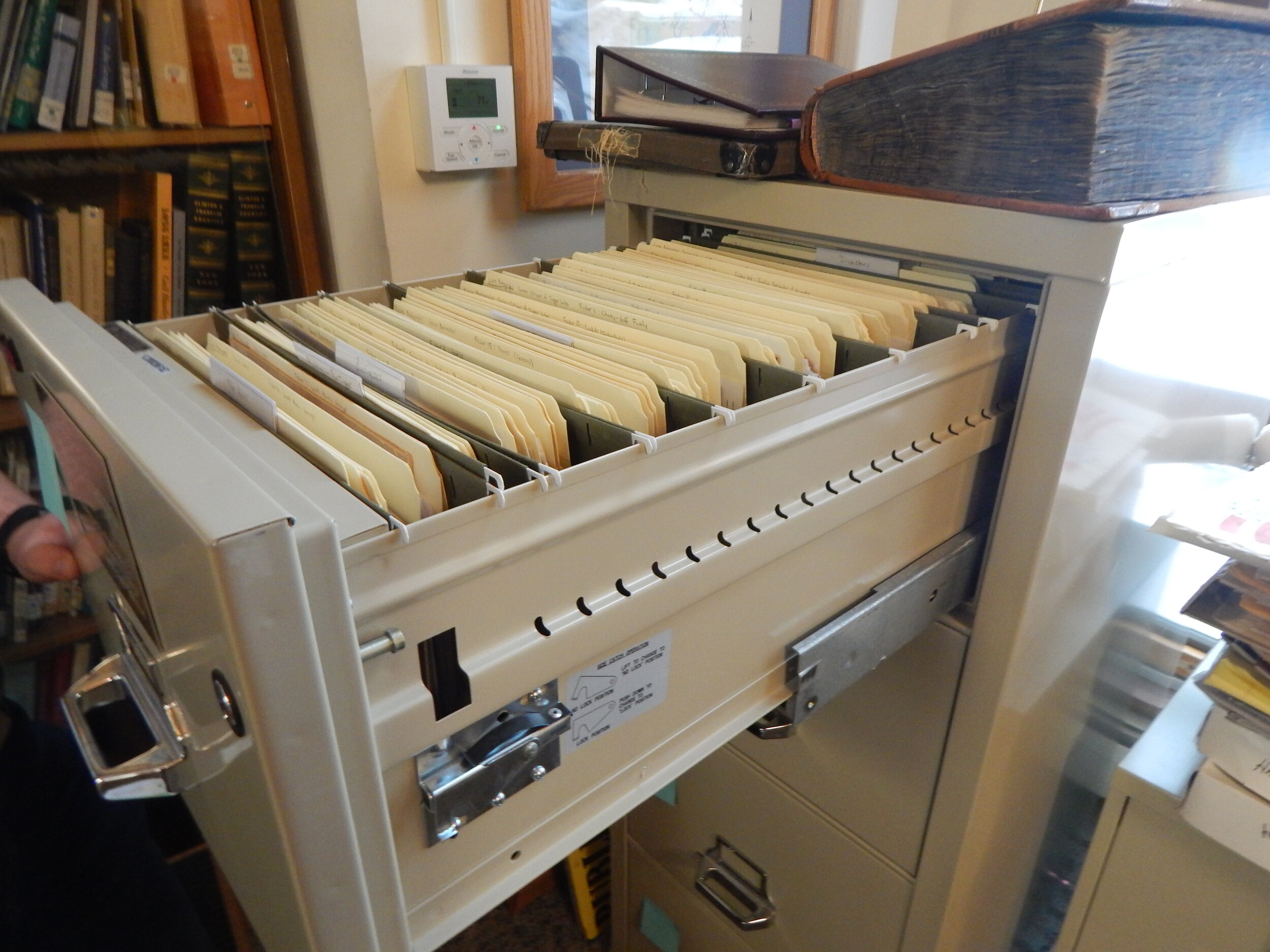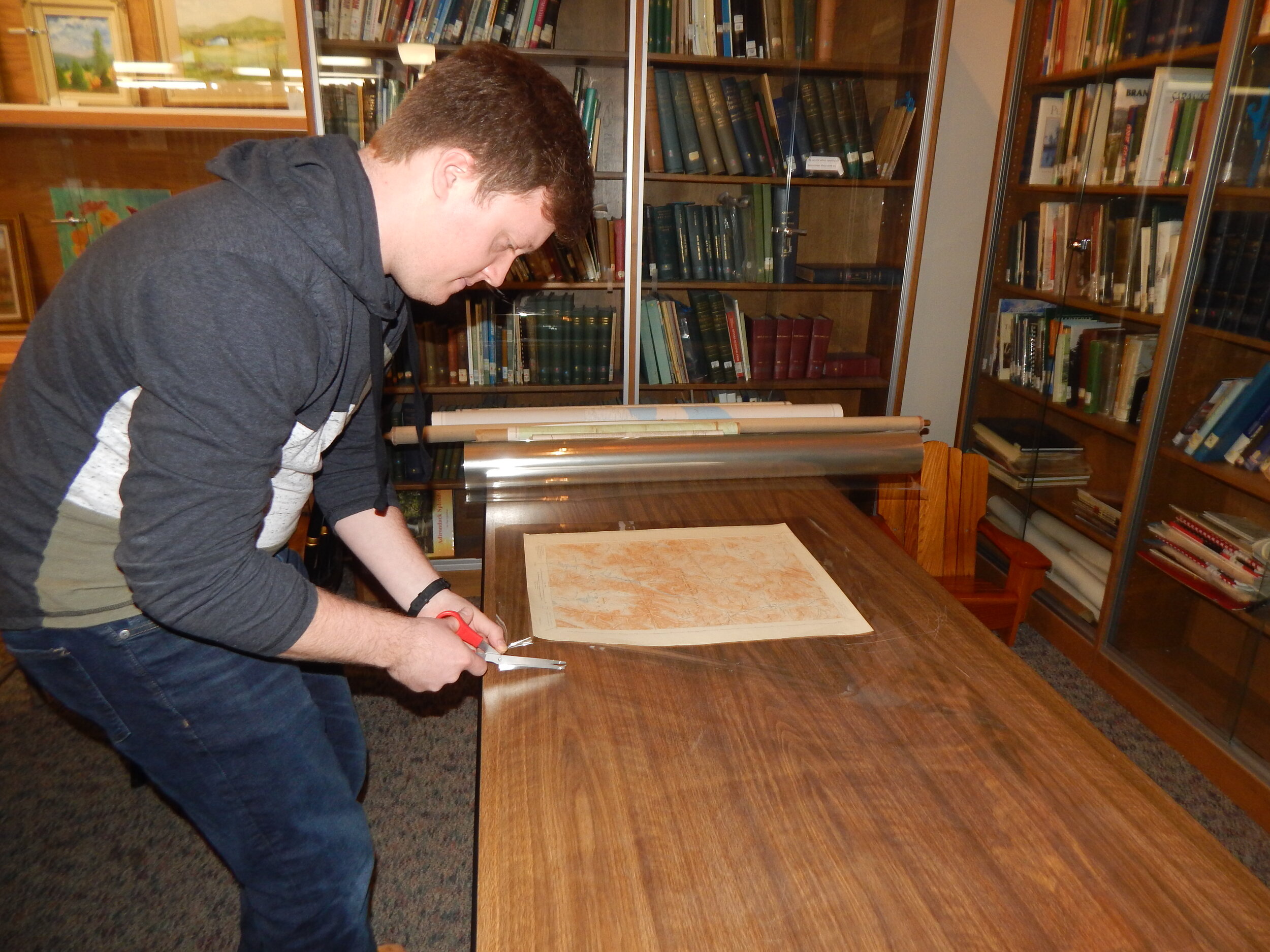Archivist working at Goff-Nelson Library to organize historical collection
Dan McClelland
by Rich Rosentreter
The Goff-Nelson Memorial Library was recently awarded a grant that allowed it to bring in an archivist to organize its significant historical collection of maps, photographs and other material and then make it more accessible to the public.
Library Director Ben Gocker last week told the Free Press that he now has archivist Conor Snow working with the library’s historical collection thanks to a $10,000 special collections grant opportunity provided by the Northern New York Library Network.
“Something I wanted to do when I took over as director is to get this local history collection organized. It a hadn’t been organized in a while. So we applied for the grant and we got the full $10,000,” Mr. Gocker said, adding that following the award of the grant money, Ellen Maroun, who overseas the Aseel Legacy Fund, offered the library a matching $10,000 that would help support the temporary project and archivist position that the grant was written for.
“Conor is going to be here for about four months. He is first processing all of the collection, which are our maps, photographs and ephemera to get physical control over it, and then as time allows, we are going to digitize as many of the photos as we can. But the first step is doing inventory, creating finding aids, process plans - all the real archival work that hadn’t been done,” Ben said.
The library director said he is more than happy to have Conor on board to work on such an important project.
“It’s been amazing. He came in here with a full head of steam and he’s been a real blessing. We are very fortunate to have him here,” he said. “What I think it means for the library is that when Conor leaves, he’ll also leave us with plans moving forward. Plans how to add collections to our local history collection. He’ll give us recommendations and advice on accessioning collections. Because he’s a trained archivist, everything that he is doing is just going to clarify the processes at the library that it hasn’t been equipped to take because we don’t have an archivist on staff,” Mr. Gocker said. “For the community what that means is resources that were formerly invisible because they haven’t been processed will now be findable.”
“A large amount of the photographed actually came in from the Tupper Lake Free Press, we have probably about 2,500 to 3,000 photos. So that’s one thing. We have maps that haven’t even been inventoried, so we didn’t even know what maps we have. We have ephemera, which can be everything from programs from picnics held by the OWD in the 1930s to a LP recording from the Holy Ghost Academy choir. So all kinds of things that people might find interesting and relevant to their own experiences in Tupper Lake,” he added. “What we’ll have as an end product are these finding aids that people will be able to access on our website and that will show very clearly the extent of these collections. Conor recently completed the findings for the photograph collection and that is a 26-page document and it lists by subject heading all the kinds of photos you will find here. Part of his project will be rehousing these in mylar sleeves which are archival quality but they also allow for a researcher or community members, with the supervision of staff, to come in and actually look at these historic photos without the risk of damaging them.”
The archivist
Conor is from Lancaster, Pennsylvania, and has a degree history and German. He eventually moved to New York City to attend New York University to pursue a Masters’ degree in archives and public history. He started the project in Tupper Lake on January 11.
“I’ve worked with different archives throughout the city, the New York Philharmonic archives, the NYU archives, the Brooklyn Historical Society. I really enjoy working with historic records, processing them, describing them, creating finding aids, working as a reference archivist and assisting researchers with the process of locating, handling and interpreting historic materials,” he said, adding that he found this job online on an archival job site. “I applied, came up and visited Tupper Lake and went from there. I really enjoy the job, it’s been great. It’s going very smoothly. So far, it’s been pretty incredible.”
Conor recently finished the first phase of going through the photographs and organizing them – and he came across many fascinating images.
“As an archivist, it can be very tempting, especially when I’m working with photographs, is to just look at each photograph for a long time and be fascinated by it, because there’s a lot of great photographs that we have here. But it is important when you’re on a timeline, because this processing of the maps, the photographs and ephemera is only about seven weeks, so I really have to make sure I keep moving,” he said, although he does get to take a little break from his methodical work processes. “I do have some times to sit back and enjoy looking at the photographs and maps and study them. I’ve been able to see a lot of stuff. There’s great photos of different students from different schools over the years, there are sports teams and bands that go all the way back to the 1880s. There’s different photographs of the loggers, the railroads going back to the 1870s.”
It is part of Conor’s job to look at each photograph to determine how to file it, but he has to pay attention to time spent.
“Sometimes if I’m not really sure what the photograph is, and there is no identifying information, either on the back or the front, sometimes I’ll ask Ben. But most of the time, I’m just happy to say this is what I think it is and just keep moving. I can’t just take ten minutes per photograph when there are more than two thousand photographs. I have to keep moving,” he said. “I’ll go back through to make sure I do a quality check of my work of course. It can be tempting to look at them for a long time.”
Many of the historical photographs at the library have been donated – a lot coming from the Tupper Lake Free Press in 2019 and that were taken by Kathleen Bigrow. Others came from a variety of sources and cover a plethora of categories. That along with the fact the collection was not organized to a particular standard made Conor’s job more challenging.
“We have a lot from different independent photograph studios from over the years and a lot individuals citizens come in to donate photographs, because we have everything from high school photographs to family reunions to stuff that came in from the Free Press and the Sunmount State School had their own photographer who donated a lot of material,” he said. “So when I came in, the collection really had not been managed for the most part. I kept on finding photos in different places, there were photos in albums that weren’t even photo albums but they were like binders with sheets of paper and sometimes I would find a photo that would fall out, or a group of photos.”
“I believe the previous library director had tried to bring some sense of order to the collection, using interns, students and volunteers who tried to organize them based on loose categories, but they really weren’t accessible because you had all these different really cool businesses and bars and restaurants, that were put under the heading of ‘Structures,’and that really doesn’t help if I’m trying to find something,” Conor explained. “My first step was just to try to get a handle of what was in here, what we call an initial survey. I survey the material, take a bunch of notes, I create an Excel spreadsheet, I have everything from what’s in this file draw to what is the condition of it, are there any duplicates, are there rusty paper clips, is there mold, is there water, are they fragile, are they tearing. I sort of analyze all those characteristics of the collection, get an idea of what’s in there and get a loose date range.”
“After that, I create what is known in our profession as a processing plan, so it’s the initial plan of getting all of the steps that are taken on paper so that I can look back at it and ask ‘what was my original plan.’ Like if I noted the rusty paper clips, I know I have to take them out.”
Conor said that phase took him three days as he continued to organize the photos.
“I was really chugging along, and then after the processing plan, I went through and I started to divide photos up in series. A certain series would be ‘Emergency Services,’ we had a lot of photos of firemen and policemen. We had another series for ‘Lumber,’ ‘Railroad,’ and ‘The Arts,’ for so any musical groups or theater programs,” he said. “So that was really up to me to determine what the series were going to be, and then I’d go through and within those series decide what items should be put in folders together and then rehouse everything in new folders. We house the series alphabetically, we house the folders alphabetically, find a new storage place for them and get starting on the finding aid, which is really just a fancy name for a guide. It’s something that we use that lists out all of the background information on the collection.”
Conor said there is also some administrative information listed such as how the collection is going to be used, who owns the rights to things, whether it can be reproduced and where it came from. He said this is meant to provide researchers as much context as possible to allow them to how they can use the material and a better sense of how to interpret the collection.
“This whole process involves preserving the physical integrity of the records and also preserving the intellectual integrity of the records, because we don’t want to just preserve the physical pieces and then to lose the background of how these pieces got here, who took care of them. All of that information is important. Provenance is something that is very important to us,” he said.
Now that the photographs are organized, Conor is now starting the same process with the library’s map collection.
“With this collection in particular, we had a lot of duplicates that I think we are going to save for preservation copies. The ones I am encasing in mylar right now, will be for access copies. This way when people come see the map they can look at them, they can hold them and also see all the information on the back. It (mylar) preserves the physical characteristics of the map,” he said. “We’re doing this for all the photographs as well, which is going to take a long time, and then they’ll be digitized to be put on the New York Digital Heritage website.”
So far with the maps, Conor has done the survey, the processing plan and all the organization as far as where he is going to place the different flat piles and what needs to go into folders.
“Right now I’m doing all the mylar sheets for the maps and then I’ll go back and finish the finding aid,” he said. “So far I haven’t touched any of the ephemera, but I have an idea of what’s there because I’ve seen some of it, but that going to be the last step in the next couple of weeks before the first part of the grant ends and we get into the digitization part of the process.”
To date, Conor is moving along well and he said he expects to have the entire job done by the time he leaves around the end of April or early May.
“Everything is going really smoothly. I think the photographs went by a lot quicker than I thought. Some of that might have been helped by some of the previous work done by the interns and volunteers by going through some of the photos and putting some of them together,” he said, adding he didn’t mind all the work. “I’m a very organizational person, I like to have my own system, so it was really nice to have the option of moving things.”
Ongoing job
Since there are thousands of photographs in the library collection, Conor said not all the people or places could be identified, but it is still something that is possible in the future.
“I think with the time I have here, that’s not going to be my number one priority. But I do know that the former library director was doing those type of events by inviting people to come in and ID people. There were a lot of photos with sticky notes attached identifying some of the people in the photos,” he said. “There were also a lot of cases in which we just didn’t know who the people were. For me, that’s not going to be the best use of my time. I do the basic things such as what is the photograph, what date was it taken, what size is the photograph.”
When things are organized and the project is done, then there will still be opportunities for the library to hold events in which people can help identify people and places in the photographs. Conor said the process doesn’t really stop.
“I think with collections, there’s always things to be done, I don’t think the work is ever actually finished,” he said. “A lot of times we’ll have additions as people continue to add to the collections.”
Goals and lessons
Conor explained what exactly the role of an archivist is and some of the things he’s learned about this village.
“To bring chaos into order. To organize, to arrange. All of these words that an archivist likes to use. That’s basically what the project is and I’m really enjoying it. It’s been really great to live in Tupper Lake and be able to drive and say ‘I know what that building is.’ I know the history behind it. I keep on learning, every day it’s something else, like Who is Alberta Moody? Why is all this named after this person or who was Goff-Nelson? Just being able to put knowledge to a name is pretty impressive,” he said. “I think that over time, especially with the photographs being digitized and made available online, people will be able to have more ease of access to say, ‘Oh, this is that person or this building is here.’”
“A lot of it, such as the photographs so far, I’ve learned a lot about the lumber industry and the history and importance of that field here. All the railroads that came through, the importance of the OWD factory. All the different churches that were around and seeing the religious history, the schools and the students, the hunting the special events that the village has like Woodsmen’s Days, Tinman Triathlon, the different festivals, the clubs and organizations, even things like disasters like the fire that happened in 1899, and even the political history and what Tupper Lake was like in the early days. You really do learn a lot about,” he said. “The type of place like this when you’re doing such a large photograph collection, it’s local history, it’s community history and that’s something that I think is very important. I am documenting and preserving and making accessible the history of Tupper Lake.”
Conor said plans to write a weekly blog post to highlight the collection.
“Maybe once a week I can take a photo of an item I’ve been working with and give a caption,” he said.
Feedback
Conor said he does get feedback from Ben and the library staff who appreciate what is being done, but most people in the community do not know about the project.
“I do go to the local restaurants and bars and churches. I am an unfamiliar face, I have a Pennsylvania license plate. They do wonder why I am here. They ask me why I’m in town and I love explaining it. Whenever I talked about their history, their ears perked up. First of all, I don’t think they really knew that this stuff existed and then the fact that it can be made accessible to them, it won’t be just at the library and they won’t be able to see it, and they can come in to see it, it’s really cool. So they welcome me with open arms in that sense,” he said. “Even though I’m an outsider, I’m not treated like one, and everyone is very friendly.”
Conor said he is very mindful of the benefits this project will bring to the community.
“Something I really want to do with this project, is benefit the people of Tupper Lake. Archives are not meant to be dust collectors. Archives are really there for accessibility that people can see. As archivists we want to make sure that records are as accessible as possible. One thing that we hate is to make some things restrictive. I always think when I am designing a finding aid is who is the audience. I really try to do all the work that I do with extra care with the audience in mind because it’s for them. It’s not just something for me to put on my resume that I did this job. It’s about how am I going to benefit the people of Tupper Lake,” he said.
And for now, this is his home too.
“I am also living in the community. I like to consider it my home away from home right now. I know people will have a strong and emotional attachments to these things and there’s nothing like seeing your history up close and personal,” he said, adding his message to the community.
“I just hope that if they see me, they’ll say hello or ask about the project because I love to explain it. I’ve really been just enjoying my time here at the library. The people and staff have been great, the town is awesome. I’m trying not to think about when it’s done, I’m trying to just enjoy every single day and every single moment that I can.”
Conor also said he appreciates Tupper Lake’s unique qualities.
“I think there are just some things that I don’t get back home. Seeing ice-fishing all the time and seeing people riding their snowmobiles around. I think it’s so cool. Every time I see it, I get really excited. To go to the Woodsmens' bar down the block and see ten snowmobiles outside, I just get a real kick out of it. I do like to go to the Woodsmens', so if you see me out, say hello.”





